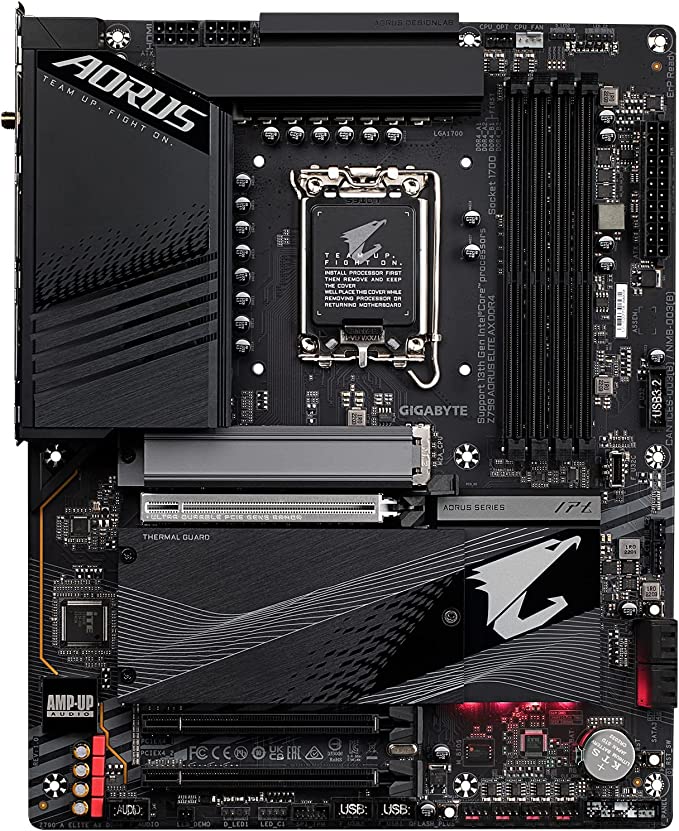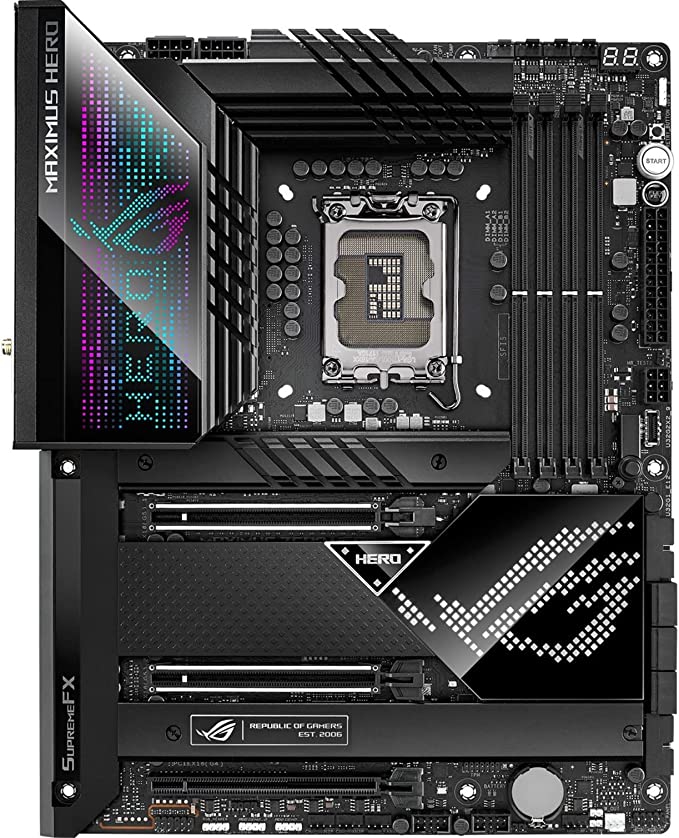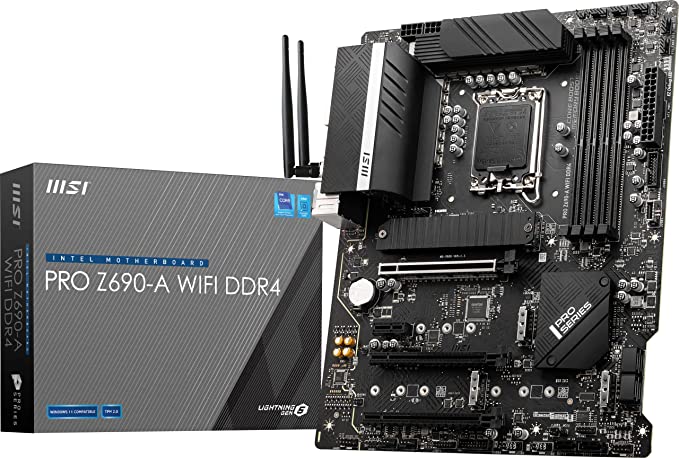You’re fulfilling your dream of building the dream pc and choosing the Intel Core i9-13900k as your CPU. But there’s been a problem; you can’t decide the best motherboards for 13900k! Here is where we come in.
The i9-13900k is the latest and greatest record-shattering processor from Intel. Launching in September 2022 it offers substantially improved performance all around the board compared to its predecessors. When its direct competitor, AMD, announced its AMD Ryzen 9 7950X, it was thought to be the biggest, worst, and most innovative CPU to date. However, Intel would answer back in full with the i9-13900k, setting a new industry standard. You can then Cinebench R23 results for yourself:
| Cinebench R23 | Intel Core i9-13900K | AMD Ryzen 9 7950X | Intel Core i9-12900K |
|---|---|---|---|
| Single-Core | 2,114 | 1,941 | 2,017 |
| Multi-core | 38,610 | 37,327 | 26,802 |
It features a record-setting 24 cores and 32 threads. The cores are then divided into an 8+16 configuration; including 8 P-cores based on the Raptor Cove architecture and 16 E-Cores based on the Gracemont core architecture. These cores are all fabricated on the 10nm ESF node. For the cache, the core carries 16MB L2 for both the P and E cores respectively, and in terms of power can reach an MTP (Maximum Turbo Power) of 253W.
Considering all of these insane specifications, it is an ordeal to select the best motherboard for the 13900k to make use of all the processing power of this CPU. That is precisely the reason why we have compiled a list of the best motherboards for the 13900k.
Best Motherboards for 13900k
| Preview | Motherboard | Award | Price |
|---|---|---|---|
 | Gigabyte Z790 AORUS ELITE AX | Best Overall | Check Price |
 | ASUS ROG Maximum Z790 HERO | High-end | Check Price |
 | MSI Pro Z690-A WiFi | Budget | Check Price |
Gigabyte Z790 AORUS ELITE AX

This GIGABYTE motherboard is one of the most cost-efficient DDR5 motherboards on the market. This motherboard provides several upgrade paths with new component interfaces and being from Gigabyte, a well-known company, it is bound to be extraordinary. Quite plainly, this is the best motherboard for the 13900k for those who are slightly conscious about the price tag.
Why should you buy this motherboard?
- The Z790 Elite X is a mid-range motherboard but in no way does it compromise on components. It is the best-value motherboard on the market featuring a standard ATX size, which is quite simplistic. This aids in reducing costs. The black PCB sports a large heatsink with numerous cooling elements on its VRMs. The rear I/O plate I/O plate has a heatsink that conceals a 6mm heat pipe and the PCB contains several RGB Fusion elements that are customizable.
- This board allows for DDR5 overclocking for over 7600MHz. This is a tried and tested feature from AORUS. However, the memory performance boosts are achieved with DDR5 XMP memory, so make sure the memory module is XMP-capable.
- The Aorus Elite AX decreases the overall impedance between the CPU memory controller and memory modules which greatly enhances CPU performance. This is one of the reasons why it is the best motherboard for the 13900k
- The PCB material itself is made from material that is server-grade. This results in a low-loss signal and maintains the high-speed signal transmission of DDR5. Moreover, it also features an Auto DDR5 booster. In the configuration settings, the user can increase the native frequency of DDR5 to 5000MHz automatically.
- For the Z790 AORUS ELITE AX, Gigabyte uses its unique stainless steel PCIe shielding. The 20% broader new PCIe 5.0 armor offers strengthened tensile strength. The SMD’s durability is increased by the various spots on its stainless steel pins that can pierce the PCB. Additionally, PCIe 5.0 supports twice the bandwidth of PCIe 4.0 and
- This motherboard is revolutionary on several connectivity fronts too. With 802.11ax WiFi 6E and Bluetooth 5, it offers better coverage and faster speeds. Spectrum congestion is often a huge issue when it comes to the WiFi environment. By providing a spacious spectrum, WiFi 6E solves this problem
Why should you not buy this motherboard?
There is not really a reason why you shouldn’t get this motherboard. It’s a great deal, covering all the core features when looking for the best motherboard for the 13900k. There are only slight issues with the motherboard. The 3rd M.2 port shares its bandwidth with two SATA ports and has no Debug LEDs. Besides this, there really isn’t much to complain about when it comes to the Gigabyte Z790 AORUS ELITE AX.
Who is this motherboard meant for?
This motherboard is meant for anybody. Whether it’s gaming or tasks related to productivity, the outstanding thermals and compatibility with the latest GPUs and CPUs make this ideal for everyone. Although we will review a higher-end MOBO on this list later, for those who want the best motherboard within a certain price range; this is pretty much it.
Asus ROG Maximum Z790 HERO

ASUS is a company all too known for not only its price tag; but the products that come along with such a price tag. While ASUS products are incredibly expensive the company is guaranteed to provide the user with something which goes above and beyond the market trend. Similarly, the Maximum Z790 HERO is the priciest motherboard on this list, costing nearly $700.
However, this MOBO has been optimized to provide the most premium experience. They have not skimped out on any aspect and have not forgotten what makes their products great.
Why should you buy this motherboard?
- The quality of the Z790 HERO is unmatched. It features an 8-layer black-on-black PCB with silver accenting on the heatsinks and shrouds. The heatsinks themselves are quite heavy and the VRMs are cooled by these deep heat skins.
- This manufacturer of the Z790 like others offers support for DDR5 with a frequency of up to 7800 MHz. Along with the cooling, and an improved VRM design, the performance you get from this motherboard is smooth and seamless.
- The focus on the cooling aspect of this product has not been overlooked by ASUS. The high conductivity thermal pads, VRM, and M.2 heatsinks, a steel backplate, and a chip heatsink make sure you won’t experience your PC components overheating. This makes it the best motherboard for the 13900k in terms of cooling.
- Moving on, this MOBO comes with plenty of other features. You get PCIe 5.0 slots and a PCIe 5.0 M.2 socket, the ROG Supreme FX ALC4082 codec with ESS SABRE DAC, ultra-fast 40 Gbps Thunderbolt 4 Type-C ports on the rear IO, 20-phase 90A VRMs. Expansion-wise, it offers the greatest versatility when it comes to storage as it offers five M.2 slots along with 6 SATA 6G ports.
- The overclocking capabilities are as insane as its price. Thanks to its 20+1 teamed power stages, a stable overclocking experience is observed especially when it comes to the 13900k. With its overclocking capabilities alone, it is nearly the best motherboard for the 13900k.
Why should you not buy this motherboard?
The absence of a 10g ethernet port is perhaps the most notable drawback of this motherboard considering this is the most expensive motherboard on the market. Besides this, the only other aspect that is detrimental to a consumer is the price point. It just doesn’t make sense to a lot of people considering they can get a MOBO with most of the features they require at nearly half the price.
Who is this motherboard meant for?
With this product, ASUS caters mainly to enthusiasts who wish to acquire the best product on the market. It may be more catering to content creators as it has a great I/O configuration. Moreover, for those who find themselves with files that an ordinary computer cannot handle, this motherboard is a great option with its M.2 and SATA 6G ports.
MSI Pro Z690-A WiFi

While many people are rushing to buy LGA1700 motherboards, many of which are expensive DDR5 models. However, MSI has formed a silver lining with its MSI Pro Z690-A WiFi. For those who just want a motherboard that can run the 13900k, this is one of the best motherboards for 13900k in that aspect.
Why should you buy this motherboard?
- This is an incredibly cheap motherboard. At around $200, you can get a MOBO that can run the 13900k perfectly fine. The reason this is a budget motherboard is due to it is priced much lower.
- A maximum memory frequency of 7200 MHz is supported along with 10 USB connections on the rear I/O. The components which are to be connected are cooled with enlarged heat skins and an M.2 shield FroZr thermal solution helps keep everything at a functioning temperature.
- With a total of four PCIe slots installed in the Pro Z790-A WiFi, MSI has definitely not missed the target when it comes to expansion slot connection. There are two full-sized x 16 slots, one PCIe 3.0 x 1 slot, and the primary PCIe 5.0 x 16 slot in addition to this. In order to support larger graphic cards, the Gen 5.0 PCIe slots have been strengthened with “steel armor.”
- With a solid power delivery system that has a 16+1+1 power stage design, the MSI Pro Z790-A WiFi vastly improves on its predecessor. Its outstanding VRM setup, which directly competes with some of the higher-end motherboards, is a wonderful demonstration of the tremendous value the motherboard delivers. Additionally, the VRM and chipset heatsink now have a larger surface area, allowing for the best heat dissipation.
Why should you not buy this motherboard?
Being a value pick, this won’t really be one of the best motherboards for 13900k. It has drastically reduced cooling features meaning you will not be able to overclock the 13900k to its maximum potential. The lack of Gen 5 M.2 slots may be another deal breaker for many people as it will really limit storage options.
Who is this motherboard meant for?
This motherboard is meant for the more budget-conscious customer. Someone who just wants to get the job done. It is by no means a bad motherboard and will excel at any gaming or professional task that you throw at it. Another excellent innovation that greatly simplifies file transfers is the USB 3.2 Gen 2 x2 connector. With a total of four PCIe slots, users can expand the device’s already excellent capability by adding numerous cards, making it suitable for content creators.
Understanding Motherboard Components
This section is meant to help you understand why we chose the motherboards we did and how you can choose one for yourself by looking for the right aspects to find the best motherboards for 13900k.
- Chipset: The bridge between the CPU, memory and other peripherals is provided by the chipset. The motherboard’s capabilities are determined by the chipset, which also aids in managing data transfer between components.
- BIOS (Basic Input/Output System): The basic input/output system, or BIOS, is the software that a computer’s microprocessor runs when it is turned on. Additionally, it controls the flow of information between the operating system (OS) of the computer and any attached hardware, including the hard drive, video adapter, keyboard, mouse, and printer.
- Power Connectors: An electrical power connector on a motherboard serves as a physical interface to power various computer system components. Power connectors are required to supply the voltage and current required to operate the various components of the computer, including the CPU, GPU, memory, and other peripherals.
Usually found on the motherboard’s edge, the power connectors are available in a variety of sizes and shapes to accommodate various components. The motherboard’s power connectors are made to fit snugly and offer a strong electrical connection.
All of the components in a computer system receive electricity through the power connections and the power supply unit (PSU). The power supply cables, which carry the power, are attached to the power connectors.
- Expansion Slots: Expansion slots are sockets on a motherboard that allow you to connect additional components such as graphics cards, sound cards, network adapters, and other peripherals. The most common types of expansion slots are:
- PCI (Peripheral Component Interconnect)
- PCI-Express (PCI-e)
- AGP (Accelerated Graphics Port)
- M.2
Each type of slot supports different speeds and bandwidths and is designed for specific types of devices.
- SATA Connectors: SATA ports are used to connect hard drives to your motherboard, including SSDs, HDDs, and CD drives. You can think of it as an interface that enables you to connect your computer’s hard disc.
SATA PORTS typically come in a variety of sorts, each of which is typically an improved version of the one before it. SATA 2.0, for instance, has a transfer speed of 3Gbps, and SATA 3.0, the most recent version, has a transfer speed of 6Gbps, or 750mb/s.
It usually depends on how many storage devices you intend to connect to your PC and to how many SATA ports you will require. It would be sufficient to have two SATA ports, but if you want to connect more hard drives, you’ll need additional SATA ports.
- CMOS Battery: Complementary Metal Oxide Semiconductor is what CMOS stands for. The BIOS firmware in your laptop is powered by the CMOS battery. Even when your computer is not plugged into a power source, BIOS must continue to function. The battery enters the picture here. The CMOS battery supplies power to BIOS when your computer is unplugged.
Both laptops and desktop computers use CMOS batteries, although laptops use them more frequently. That’s because desktop computers are frequently left unplugged for shorter periods of time than laptops. The majority of desktop computers are rarely removed from their power source.
Every time your laptop is plugged in, the CMOS battery is charged. The battery only loses charge when your laptop is unplugged. The typical battery life is 2 to 10
- I/O Connectors: In the computer business, the word “port” is frequently used and has a variety of meanings depending on the technology being discussed. I/O ports enable hardware connectivity. Either internal or external hardware may be used. The copper circuits and memory ranges connected to the ports enable data exchange between the CPU, RAM, and the ports themselves. USB and FireWire I/O ports are popular choices. Additionally included in this part are SCSI, audio connectors, MIDI, and RG-6 coaxial interfaces. Even while the USB port on modern systems is the most crucial I/O port, you may also come across other ports, including legacy ports like serial and parallel.
Verdict
Concluding our list of the best motherboards for the 13900k, we hope you were able to find what you’ve been looking for. When it comes to high-end motherboards like the aforementioned ones, there really won’t be something that is unable to give you exceptional performance.
Looking for the best value? Get the Gigabyte Z790 AORUS ELITE AX. In a completely justifiable price, it features more than enough features to qualify it as the best speaker for the i9-13900k. Getting this MOBO, you will find next to nothing to complain about.
If you’re an enthusiast and looking for the best MOBO money can buy, there is no better choice than the Asus ROG Maximum Z790 HERO. It comes loaded with every feature a top-of-the-line motherboard can offer.
Lastly, for a budget user, MSI Pro Z690-A WiFi will be more than enough to satisfy your needs. Yes, there are performance drawbacks, but if you can deal with those drawbacks this is an amazing offer.
Be sure to know what components you deem are most important to your needs and buy accordingly. After all, the best motherboard for the 13900k is subjective.
Check out some of our other articles and categories:
Computers, Laptops, Gaming, Custom builds
Building a Cool Purple PC Setup

